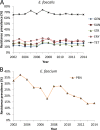Prevalence and Antimicrobial Resistance of Enterococci Isolated from Retail Meats in the United States, 2002 to 2014
- PMID: 29030448
- PMCID: PMC5734015
- DOI: 10.1128/AEM.01902-17
Prevalence and Antimicrobial Resistance of Enterococci Isolated from Retail Meats in the United States, 2002 to 2014
Abstract
Bacteria of the genus Enterococcus are important human pathogens that are frequently resistant to a number of clinically important antibiotics. They are also used as markers of animal fecal contamination of human foods and are employed as sentinel organisms for tracking trends in resistance to antimicrobials with Gram-positive activity. As part of the National Antimicrobial Resistance Monitoring System (NARMS), we evaluated several retail meat commodities for the presence of enterococci from 2002 to 2014, and we found 92.0% to be contaminated. The majority of isolates were either Enterococcus faecalis (64.0%) or Enterococcus faecium (28.6%), and the antimicrobial resistance of each isolate was assessed by broth microdilution. The resistance prevalences for several drugs, including erythromycin and gentamicin, were significantly higher among poultry isolates, compared to retail beef or pork isolates. None of the isolates was resistant to the clinically important human drug vancomycin, only 1 isolate was resistant to linezolid, and resistance to tigecycline was below 1%. In contrast, a majority of both E. faecalis (67.5%) and E. faecium (53.7%) isolates were resistant to tetracycline. Overall, the robust NARMS testing system employed consistent sampling practices and methods throughout the testing period, with the only significant trend in resistance prevalence being decreased E. faecium resistance to penicillin. These data provide excellent baseline levels of resistance that can be used to measure future changes in resistance prevalence that may result from alterations in the use of antimicrobials in food animal production.IMPORTANCE Enterococci, including E. faecalis and E. faecium, are present in the guts of food-producing animals and are used as a measure of fecal contamination of meat. We used the large consistent sampling methods of NARMS to assess the prevalence of Enterococcus strains isolated from retail meats, and we found over 90% of meats to be contaminated with enterococci. We also assessed the resistance of the Enterococcus strains, commonly used as a measure of resistance to agents with Gram-positive activity, in foods. Resistance prevalence was over 25% for some antimicrobials and sample sources but was less than 1% for several of the most important therapeutic agents used in human medicine.
Keywords: Enterococcus; antimicrobial resistance; retail meats.
This is a work of the U.S. Government and is not subject to copyright protection in the United States. Foreign copyrights may apply.
Figures



Similar articles
-
Characterization of antimicrobial resistance and virulence genes in Enterococcus spp. isolated from retail meats in Alberta, Canada.Int J Food Microbiol. 2012 Jun 1;156(3):222-30. doi: 10.1016/j.ijfoodmicro.2012.03.026. Epub 2012 Mar 29. Int J Food Microbiol. 2012. PMID: 22520502
-
Prevalence and antimicrobial resistance of enterococcus species isolated from retail meats.Appl Environ Microbiol. 2003 Dec;69(12):7153-60. doi: 10.1128/AEM.69.12.7153-7160.2003. Appl Environ Microbiol. 2003. PMID: 14660361 Free PMC article.
-
Antimicrobial susceptibility of enterococci recovered from healthy cattle, pigs and chickens in nine EU countries (EASSA Study) to critically important antibiotics.Vet Microbiol. 2018 Mar;216:168-175. doi: 10.1016/j.vetmic.2018.02.010. Epub 2018 Feb 10. Vet Microbiol. 2018. PMID: 29519512
-
Antimicrobial-resistant enterococci in animals and meat: a human health hazard?Foodborne Pathog Dis. 2010 Oct;7(10):1137-46. doi: 10.1089/fpd.2010.0552. Foodborne Pathog Dis. 2010. PMID: 20578915 Review.
-
Human health risks associated with antimicrobial-resistant enterococci and Staphylococcus aureus on poultry meat.Clin Microbiol Infect. 2016 Feb;22(2):130-140. doi: 10.1016/j.cmi.2015.12.003. Epub 2015 Dec 17. Clin Microbiol Infect. 2016. PMID: 26706616 Review.
Cited by
-
Does Bovine Raw Milk Represent a Potential Risk for Vancomycin-Resistant Enterococci (VRE) Transmission to Humans?Antibiotics (Basel). 2025 Aug 8;14(8):814. doi: 10.3390/antibiotics14080814. Antibiotics (Basel). 2025. PMID: 40868008 Free PMC article.
-
Antimicrobial resistance in Enterococcus faecium and Enterococcus faecalis isolates of swine origin from eighteen provinces in China.J Vet Med Sci. 2021 Dec 23;83(12):1952-1958. doi: 10.1292/jvms.21-0413. Epub 2021 Nov 16. J Vet Med Sci. 2021. PMID: 34789595 Free PMC article.
-
Molecular characteristics of optrA-carrying Enterococcus faecalis from chicken meat in South Korea.Poult Sci. 2020 Dec;99(12):6990-6996. doi: 10.1016/j.psj.2020.08.062. Epub 2020 Sep 12. Poult Sci. 2020. PMID: 33248615 Free PMC article.
-
Molecular Characterization of Enterococcus faecalis and Enterococcus faecium Isolated from a Meat Source in Shahrekord Local Markets, Iran.Arch Razi Inst. 2023 Aug 31;78(4):1387-1396. doi: 10.32592/ARI.2023.78.4.1387. eCollection 2023 Aug. Arch Razi Inst. 2023. PMID: 38226377 Free PMC article.
-
Prevalence and Antimicrobial Susceptibility of Indicator Organisms Escherichia coli and Enterococcus spp. Isolated from U.S. Animal Food, 2005-2011.Microorganisms. 2020 Jul 15;8(7):1048. doi: 10.3390/microorganisms8071048. Microorganisms. 2020. PMID: 32679763 Free PMC article.
References
-
- Lebreton F, Willems RJL, Gilmore MS. 2014. Enterococcus diversity, origins in nature, and gut colonization. In Gilmore MS, Clewell DB, Ike Y, Shankar N (ed), Enterococci: from commensals to leading causes of drug resistant infection. Massachusetts Eye and Ear Infirmary, Boston, MA. - PubMed
-
- Hunt CP. 1998. The emergence of enterococci as a cause of nosocomial infection. Br J Biomed Sci 55:149–156. - PubMed
-
- Bhavnani SM, Drake JA, Forrest A, Deinhart JA, Jones RN, Biedenbach DJ, Ballow CH. 2000. A nationwide, multicenter, case-control study comparing risk factors, treatment, and outcome for vancomycin-resistant and -susceptible enterococcal bacteremia. Diagn Microbiol Infect Dis 36:145–158. doi:10.1016/S0732-8893(99)00136-4. - DOI - PubMed
MeSH terms
Substances
LinkOut - more resources
Full Text Sources
Other Literature Sources
Medical
Molecular Biology Databases
Research Materials

